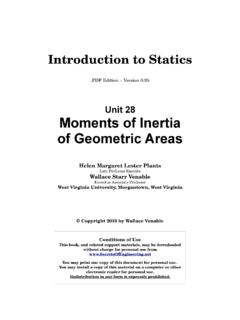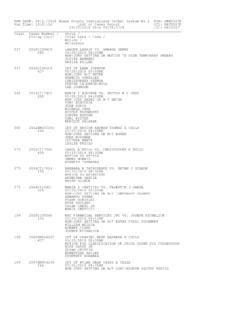Transcription of Unit 29 Moments of Inertia of Composite Areas
1 Introduction to Edition Version 29 Moments of Inertia of Composite AreasHelen Margaret Lester PlantsLate Professor EmeritaWallace Starr VenableEmeritus Associate ProfessorWest Virginia University, Morgantown, West Virginia Copyright 2010 by Wallace VenableConditions of UseThis book, and related support materials, may be downloaded without charge for personal use may print one copy of this document for personal use. You may install a copy of this material on a computer or other electronic reader for personal in any form is expressly 29 Moments of Inertiaof Composite AreasFrame 29-1 Introduction This unit will teach you how to combine the Moments of Inertia of simple geometric shapes to obtain the moment of Inertia of a Composite area.
2 It will also teach you how not to combine of Inertia of Areas are used extensively in "strength" to calculate stresses and deflections in beams. In American Customary Units we calculate stress in pounds per square inch (psi) so it is the common practice to use Areas (and derived properties) measured in inches. Conveniently, most American drawings have Areas dimensioned in System International (SI) stresses are calculated in Pascals (Newtons per square meter) so it is the common practice to use area Areas (and derived properties) measured in meters. For better or worse, cross-sections in most SI engineering drawings are labeled in centimeters or this unit the "correct" units in answers will be in terms of inches or system used for finding the second moment for Composite Areas is very similar to that used for finding the first Moments and centroids of Composite Areas .
3 It would probably pay you to review your notebook for Unit 12 before beginning the new work. When you have done so, go to the next response to preceding frame No responseFrame 29-2 Common Axis Second Moments of Areas may be added directly if the Moments of the Areas are with respect to the same rectangle AIy = _____For rectangle BIy = _____For the Composite area Iy = _____Express your answers in in4 Correct response to preceding frameFrame 29-3 Common Axis The general expression for the moment of Inertia of a rectangle about an edge is For part AIa-a = _____For part BIa-a = _____For the entire areaIa-a = _____Correct response to preceding frameFrame 29-4 Common Axis It is also possible to subtract Moments of Inertia of various Areas as long as the Moments
4 Are taken about the same axis. This allows us to compute the moment of Inertia for an area with a the moment of Inertia of the hollow circle by computing the following:For a circle of 20 mm radiusIx = _____For a circle of 10 mm radiusIx = _____For the ringIx = _____Express your answers in m4 Correct response to preceding frameFrame 29-5 Common AxisFind the moment of Inertia of the area shown about the x-axis and about the = _____Iy = _____Correct response to preceding frameFrame 29-6 Common Axis The moment of Inertia of a quarter-circle about its edge isFind I x and I y for the semi-circle. Ix = _____Iy = _____Correct response to preceding frameFrame 29-7 Common Axis The moment of Inertia of any triangle may be found by combining the Moments of Inertia of right triangles about a common I y for the isosceles triangle shown.
5 Look up I for a triangle in your table if you have = _____Correct response to preceding frameFrame 29-8 Common Axis Find I x for the isosceles triangle x = _____Correct response to preceding frameFrame 29-9 Common Axis Find I x and I y for the scalene triangle calculating centroids of Composite Areas I find it useful to use a tabular approach, similar to the one we used with response to preceding frameFrame 29-10 Common Axis Complete page 29-1 of your response to preceding frameFrame 29-11 Transition By now you have probably acquired an excellent grasp of common axis : It is not always possible to find a single axis about which the Moments of Inertia of all parts are known.
6 In fact, it can't be done more often than it can, and if you can find such an axis it usually isn't the one you want, so you need to know something "something more" is usually called the parallel axis theorem and the next group of frames will help you learn to the next response to preceding frame No responseFrame 29-12 Parallel Axis Theorem The parallel axis theorem is most simply stated as an equation,I xa = I xG + Ad2 Stated in words it says that the moment of Inertia about any axis (I xa) is equal to the sum of the moment of Inertia of the area about a parallel axis through its centroid (I xG) plus the product of the area and the square of the distance between (Ad2.)
7 (Comparing the equation and the statement does tend to make one appreciate the equation.)Go to the next response to preceding frame No responseFrame 29-13 Parallel Axis Theorem The equationI xa = I xG + Ad2implies that the moment of Inertia of an area about an axis passing through the centroid of the area is (larger , smaller) than the moment of Inertia about any other parallel response to preceding frame smallerFrame 29-14 Parallel Axis Theorem The term Ad 2 is often called the "transfer term" and d, the "transfer distance".To transfer the moment of Inertia from the centroidal axis to any other axis the transfer term is (added , subtracted).Correct response to preceding frame addedFrame 29-15 Transfer Equation The Parallel Axis Theorem is, strictly speaking, the word version given in an earlier more convenient algebraic form is usually called the "Transfer Equation.
8 " Write the transfer = _____Correct response to preceding frame Frame 29-16 Parallel Axis Theorem For the area shown, the centroid is located in. from the y axis. So, Find I xIx = _____Correct response to preceding frameFrame 29-17 Parallel Axis Theorem Find I x for the triangle shown. Begin by drawing in the centroidal x-axis. Correct response to preceding frameFrame 29-18 Transfer Equation It is also possible to use the transfer equation in reverse. To do so you must know the moment of Inertia about a non-centroidal axis and want to find it about the centroidal this case the equation for I xG isIxG = _____Correct response to preceding frame Frame 29-19 Transfer Equation Find I xG for the quarter = _____Correct response to preceding frameFrame 29-20 Notebook Do page 29-2 in your notebook.
9 Then complete the Properties of Areas Table on page 28-4 in your response to preceding frameFrame 29-21 Limitation There is one important limitation on the use of the transfer equation. One of the Moments of Inertia involved must be centroidal. It is impossible to transfer directly from one non-centroidal axis to each of the following tell whether the transfer equation Axis a-a to axis b-b$ Yes$ No2. Axis b-b to axis c-c$ Yes$ No3. Axis a-a to axis c-c$ Yes$ NoCorrect response to preceding frame1. Yes2. Yes 3. NoFrame 29-22 Transfer Equation Of course it is possible to go from any axis to any axis by an indirect the triangle shown:Ix = 180 in4 First find I GIG = _____Now find I a-aIa-a = _____Correct response to preceding frameAll of which is rather silly since most people would simply begin by finding IxG.
10 However, it can be done this way if one really needs 29-23 Transition Now you have all the necessary tools for finding Moments of Inertia of Composite Areas . All that remains is to learn to use them on Composite remainder of this unit will be devoted to some pretty complex Areas and a handy method for cutting the computations down to is a good place for a break. I suggest you take one before turning the response to preceding frame No responseFrame 29-24 Composite Areas by Transfer The moment of Inertia of a Composite area about any axis may be found by finding the Moments of Inertia of all parts about the axis by means of the transfer equation and then adding is usually a good idea to do this by means of a table.





